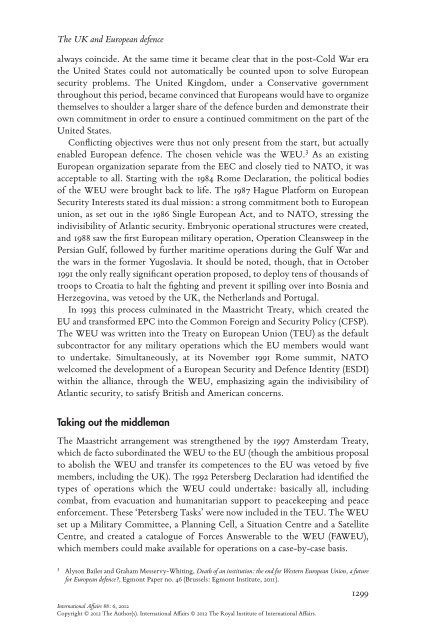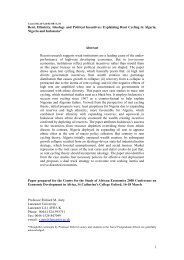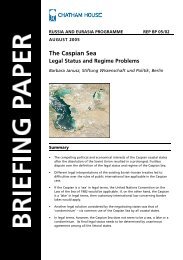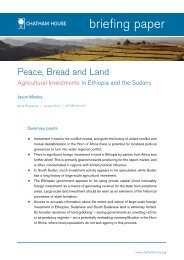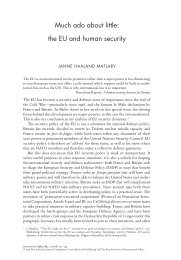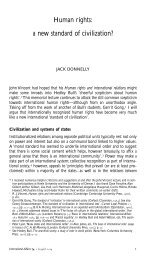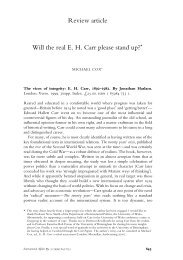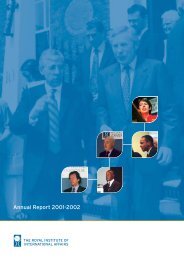The UK and European defence: leading or leaving? - Chatham House
The UK and European defence: leading or leaving? - Chatham House
The UK and European defence: leading or leaving? - Chatham House
Create successful ePaper yourself
Turn your PDF publications into a flip-book with our unique Google optimized e-Paper software.
<strong>The</strong> <strong>UK</strong> <strong>and</strong> <strong>European</strong> <strong>defence</strong><br />
always coincide. At the same time it became clear that in the post-Cold War era<br />
the United States could not automatically be counted upon to solve <strong>European</strong><br />
security problems. <strong>The</strong> United Kingdom, under a Conservative government<br />
throughout this period, became convinced that <strong>European</strong>s would have to <strong>or</strong>ganize<br />
themselves to shoulder a larger share of the <strong>defence</strong> burden <strong>and</strong> demonstrate their<br />
own commitment in <strong>or</strong>der to ensure a continued commitment on the part of the<br />
United States.<br />
Conflicting objectives were thus not only present from the start, but actually<br />
enabled <strong>European</strong> <strong>defence</strong>. <strong>The</strong> chosen vehicle was the WEU. 3 As an existing<br />
<strong>European</strong> <strong>or</strong>ganization separate from the EEC <strong>and</strong> closely tied to NATO, it was<br />
acceptable to all. Starting with the 1984 Rome Declaration, the political bodies<br />
of the WEU were brought back to life. <strong>The</strong> 1987 Hague Platf<strong>or</strong>m on <strong>European</strong><br />
Security Interests stated its dual mission: a strong commitment both to <strong>European</strong><br />
union, as set out in the 1986 Single <strong>European</strong> Act, <strong>and</strong> to NATO, stressing the<br />
indivisibility of Atlantic security. Embryonic operational structures were created,<br />
<strong>and</strong> 1988 saw the first <strong>European</strong> military operation, Operation Cleansweep in the<br />
Persian Gulf, followed by further maritime operations during the Gulf War <strong>and</strong><br />
the wars in the f<strong>or</strong>mer Yugoslavia. It should be noted, though, that in October<br />
1991 the only really significant operation proposed, to deploy tens of thous<strong>and</strong>s of<br />
troops to Croatia to halt the fighting <strong>and</strong> prevent it spilling over into Bosnia <strong>and</strong><br />
Herzegovina, was vetoed by the <strong>UK</strong>, the Netherl<strong>and</strong>s <strong>and</strong> P<strong>or</strong>tugal.<br />
In 1993 this process culminated in the Maastricht Treaty, which created the<br />
EU <strong>and</strong> transf<strong>or</strong>med EPC into the Common F<strong>or</strong>eign <strong>and</strong> Security Policy (CFSP).<br />
<strong>The</strong> WEU was written into the Treaty on <strong>European</strong> Union (TEU) as the default<br />
subcontract<strong>or</strong> f<strong>or</strong> any military operations which the EU members would want<br />
to undertake. Simultaneously, at its November 1991 Rome summit, NATO<br />
welcomed the development of a <strong>European</strong> Security <strong>and</strong> Defence Identity (ESDI)<br />
within the alliance, through the WEU, emphasizing again the indivisibility of<br />
Atlantic security, to satisfy British <strong>and</strong> American concerns.<br />
Taking out the middleman<br />
<strong>The</strong> Maastricht arrangement was strengthened by the 1997 Amsterdam Treaty,<br />
which de facto sub<strong>or</strong>dinated the WEU to the EU (though the ambitious proposal<br />
to abolish the WEU <strong>and</strong> transfer its competences to the EU was vetoed by five<br />
members, including the <strong>UK</strong>). <strong>The</strong> 1992 Petersberg Declaration had identified the<br />
types of operations which the WEU could undertake: basically all, including<br />
combat, from evacuation <strong>and</strong> humanitarian supp<strong>or</strong>t to peacekeeping <strong>and</strong> peace<br />
enf<strong>or</strong>cement. <strong>The</strong>se ‘Petersberg Tasks’ were now included in the TEU. <strong>The</strong> WEU<br />
set up a Military Committee, a Planning Cell, a Situation Centre <strong>and</strong> a Satellite<br />
Centre, <strong>and</strong> created a catalogue of F<strong>or</strong>ces Answerable to the WEU (FAWEU),<br />
which members could make available f<strong>or</strong> operations on a case-by-case basis.<br />
3 Alyson Bailes <strong>and</strong> Graham Messervy-Whiting, Death of an institution: the end f<strong>or</strong> Western <strong>European</strong> Union, a future<br />
f<strong>or</strong> <strong>European</strong> <strong>defence</strong>?, Egmont Paper no. 46 (Brussels: Egmont Institute, 2011).<br />
International Affairs 88: 6, 2012<br />
Copyright © 2012 <strong>The</strong> Auth<strong>or</strong>(s). International Affairs © 2012 <strong>The</strong> Royal Institute of International Affairs.<br />
1299


